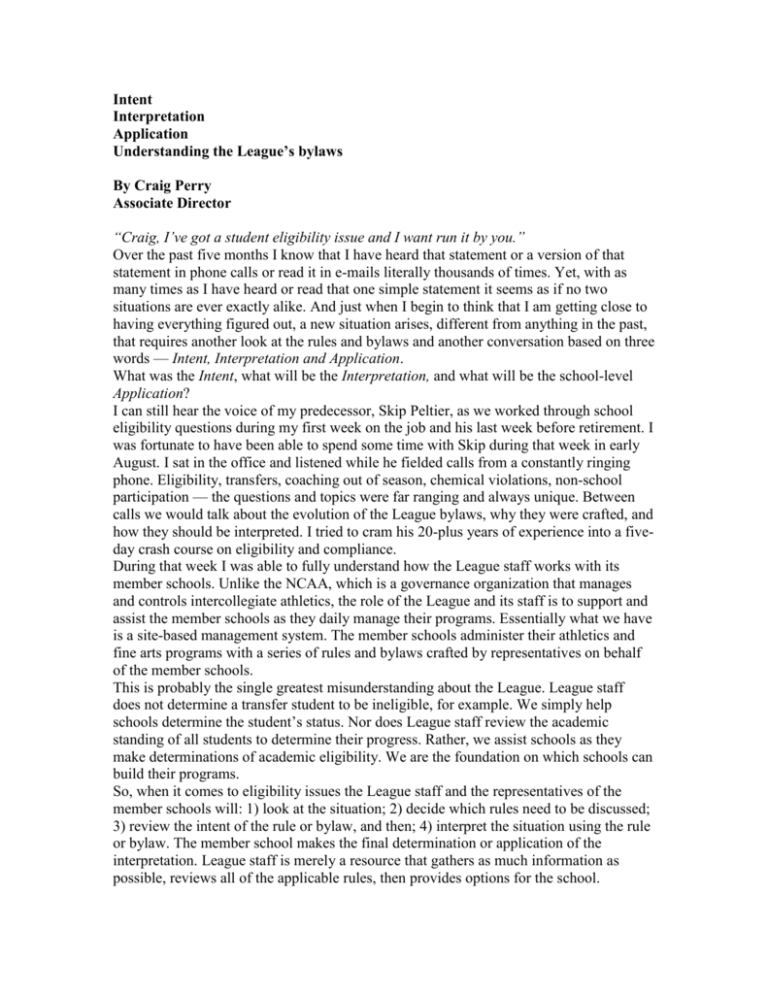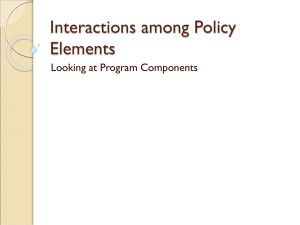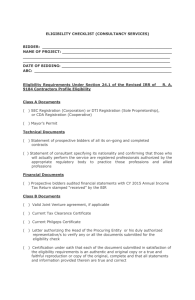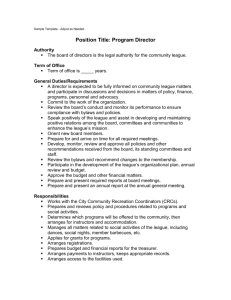Intent, Interpretation, Application
advertisement

Intent Interpretation Application Understanding the League’s bylaws By Craig Perry Associate Director “Craig, I’ve got a student eligibility issue and I want run it by you.” Over the past five months I know that I have heard that statement or a version of that statement in phone calls or read it in e-mails literally thousands of times. Yet, with as many times as I have heard or read that one simple statement it seems as if no two situations are ever exactly alike. And just when I begin to think that I am getting close to having everything figured out, a new situation arises, different from anything in the past, that requires another look at the rules and bylaws and another conversation based on three words — Intent, Interpretation and Application. What was the Intent, what will be the Interpretation, and what will be the school-level Application? I can still hear the voice of my predecessor, Skip Peltier, as we worked through school eligibility questions during my first week on the job and his last week before retirement. I was fortunate to have been able to spend some time with Skip during that week in early August. I sat in the office and listened while he fielded calls from a constantly ringing phone. Eligibility, transfers, coaching out of season, chemical violations, non-school participation — the questions and topics were far ranging and always unique. Between calls we would talk about the evolution of the League bylaws, why they were crafted, and how they should be interpreted. I tried to cram his 20-plus years of experience into a fiveday crash course on eligibility and compliance. During that week I was able to fully understand how the League staff works with its member schools. Unlike the NCAA, which is a governance organization that manages and controls intercollegiate athletics, the role of the League and its staff is to support and assist the member schools as they daily manage their programs. Essentially what we have is a site-based management system. The member schools administer their athletics and fine arts programs with a series of rules and bylaws crafted by representatives on behalf of the member schools. This is probably the single greatest misunderstanding about the League. League staff does not determine a transfer student to be ineligible, for example. We simply help schools determine the student’s status. Nor does League staff review the academic standing of all students to determine their progress. Rather, we assist schools as they make determinations of academic eligibility. We are the foundation on which schools can build their programs. So, when it comes to eligibility issues the League staff and the representatives of the member schools will: 1) look at the situation; 2) decide which rules need to be discussed; 3) review the intent of the rule or bylaw, and then; 4) interpret the situation using the rule or bylaw. The member school makes the final determination or application of the interpretation. League staff is merely a resource that gathers as much information as possible, reviews all of the applicable rules, then provides options for the school. Let me offer an example using a student transfer situation to demonstrate how Intent, Interpretation, and Application work. A student, currently in the middle of her 10th grade year attending a public high school in the school district where her parents live, would like to transfer from her current school to another Minnesota school. What are her options and how does transfer affect her eligibility? Minnesota Statutes first crafted in the late 1980s helped guarantee students the opportunity to choose the type of high school education they wished to receive. Rather than be limited to attending only the school in the district where their parents live, students were granted the opportunity to open enroll — to attend their school of choice. Public schools, private schools, home schools, charter schools and now online schools are just some of the options available to students. The intent was to give students academic choice, to provide them the opportunity to determine the type of high school education they want to receive. League member schools recognized the intent of those laws and created a system that allows for the freedom of academic choice while at the same time addresses the varsity eligibility of those same transfer students. Member schools wanted to create a system that allowed some movement from school to school without a loss of varsity eligibility. Intent: The intent of open enrollment, guaranteed by Minnesota Statute, was to provide high school students the opportunity to choose the type of high school education they wanted to receive. League member schools created student transfer policies that recognize this student choice, but also decided to limit the varsity eligibility of those transfer students. Interpretation: Using the example above, we need to look at all of the conditions of Bylaw 111 — Transfer and Residence. The very foundation of the transfer rule is based on parental residency. Student-athletes are eligible for participation in the school district where their parents reside. Here are the conditions that must exist if a student is going to transfer without a corresponding loss of varsity eligibility: The student transfers from one school district attendance area to another school district attendance area and there is a corresponding change in the residency and occupancy of the parents to the new district. In other words, the parents move to a new district and the student moves with them. The student is enrolled in the 9th grade for the first time. Incoming 9th graders in this state can choose to attend any Minnesota school and be varsity eligible without a corresponding parental residency change. The student’s residence is changed pursuant to a child protection order, placement in a foster home, or a juvenile court disposition order. The student uses the one-time option, often referred to as the “Open Enrollment” option, and meets two criteria: 1) the transfer must be from a Minnesota school to a Minnesota school, and; 2) the student was fully eligible and attended the last day of school of the previous year at the former school, then enrolls in and attends the first day of school at the new school and meets the provisions of Minnesota state law for open enrollment. Using this information the school and League staff will review the situation. League staff will then provide an interpretation of the rules and bylaws to the school administrator. In this case the interpretation would be that the student does not meet the conditions listed above and would then have a loss of varsity eligibility. Because none of the provisions above were met, the student is immediately ineligible for varsity competition for a period equal to 50 percent (rounded up to the next whole number) of the regular season varsity games scheduled in each sport in which the student participates. That period of ineligibility shall be for one calendar year (365 days), beginning with the first day of attendance in the new school. Application: After League staff has provided an interpretation the member school then applies the interpretation. In this case, the school was able to interpret the bylaw and determine the student to be 50 percent ineligible as described above. If the school in this example decided to make the student eligible and allowed the student-athlete to participate at the varsity level immediately, it would have been a bylaw violation of using an ineligible player which would result in suspensions and forfeitures of contests. Understanding eligibility is not unlike peeling an onion — the closer we think we are getting to the center, the more layers we realize we have to peel away. Yet only by peeling away the many layers can we get to the center, a center in this case is an interpretation of a student athlete’s eligibility. I have provided a relatively simple example to demonstrate the process. Imagine the layers that have to be peeled away when we add home schools, charter schools, area learning centers, online schools, multiple-school transfers, and chemical eligibility penalties. In the Spring 2006 Bulletin I will review eligibility for student athletes and how it is affected by violations of the Chemical Policy.





